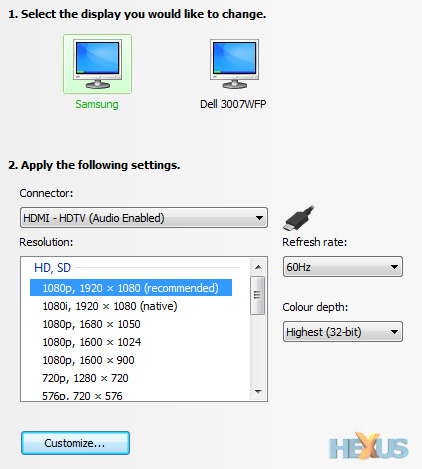Setup and usage
The mere thought of wireless networking might be enough to put off novice users, but if you're after a plug-and-play-like solution, you're in luck; setting up KFA's WHDI graphics card is a piece of cake.
As both the WHDI card and receiver are pre-paired, it's simply a matter of installing the two and powering on. With the card up and running and the receiver connected to a nearby TV via HDMI, Windows automatically detects that two displays are available - and users are given all the usual multi-monitor configuration options, including the ability to mirror or extend the desktop, or apply independent resolutions.

Our Samsung HDTV is detected almost instantaneously - we even get to see the BIOS boot sequence - and NVIDIA's GeForce control panel confirms that the WHDI graphics card is HDCP compliant.
Getting the wireless system in place for video, audio and USB (32-bit only) is easy enough, and with our PC and HDTV separated by a wall and a distance of roughly 25 feet, the signal delivered impressive results. DVDs and Blu-rays played back perfectly, with excellent image quality and perfectly synchronised audio.
The GTX 460 GPU is overkill for watching movies, though, so we fired up a couple of games and witnessed similarly-impressive results. Call of Duty: Black Ops, Just Cause 2 and Formula 1 2010 were all beamed through the air without a stutter, and we were very pleasantly surprised by system responsiveness. At our initial distance of 25 feet, we couldn't notice any input lag or latency.
But the result wasn't so clear cut when we moved the graphics card and receiver further apart. Putting the two on separate floors, at a distance of roughly 35 feet through a ceiling and two walls, proved to be a little too much and resulted in on-screen artifacts, audio breakups and frequent disconnections.
The card's WHDI technology works well, but like all wireless solutions, it'll only take you so far and performance will vary depending on user environment; everything from the thickness of walls to the number of devices broadcasting wireless signals can have an impact. To get an idea of how good it can be, and how badly signal can degrade, check out our trio of demo clips below.
Demo 1: Wireless gaming at a range of 25 feet
No problems gaming in our test environment at a range of 25 feet. Our video capture doesn't do justice to the on-screen image quality and our driving skills leave a lot to be desired, but take our word for it; F1 2010 was delivered to our HDTV looking smooth as silk without any signs of input lag.
Demo 2: Wireless 1080p video streaming at a range of 25 feet
Video performance is spot on at this range, too. Our 1080p sample clip arrived perfectly in sync, and while a close-up examination revealed that image quality was slightly lower than when playing the same clip direct to the TV from a USB stick, it was tough to tell the difference.
Demo 3: Wireless 1080p video streaming at a range of over 35 feet across floors
But the wireless signal can only take you so far. Putting an extra floor between our GPU transmitter and our set-top receiver made the WHDI system struggle to communicate. Video streaming, as shown in the above clip, became grainy with visible on-screen artifacts leading up to an eventual dropout. At this range, in our unique environment, input lag also made our games practically unplayable.
Overall, this particular WHDI solution can deliver impressive results, but as with most other wireless options, don't forget the golden rule; your mileage will vary.









